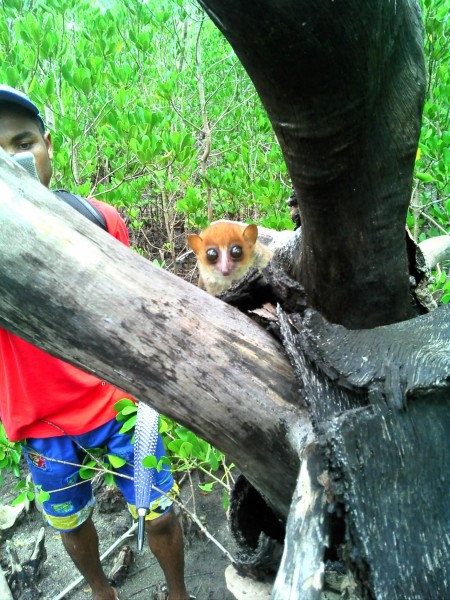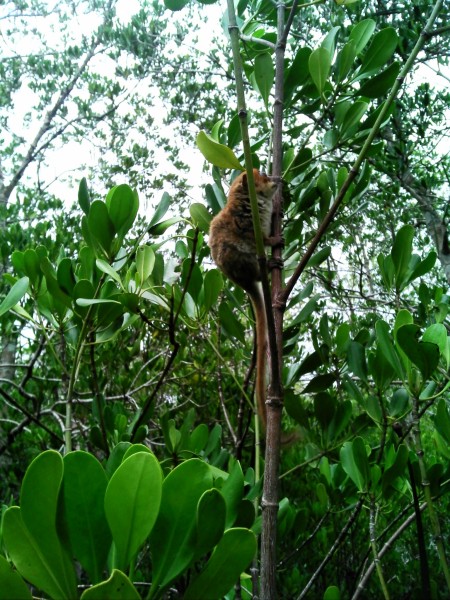[avatar user=”zo” size=”thumbnail” align=”left” link=”http://blog.blueventures.org/author/zo/” target=”_blank” /] by Zo Andriamahenina, Geospatial Scientist, Blue Forests, Madagascar
 We were nearing the end of five months of forest inventory work in the mangroves of Ambaro-Ambanja Bay, northwest Madagascar. After almost three weeks of solid rain during our stay in the village of Antsahampano it looked like today would be no different. Our team of seven, including BV staff and local community members, left the village early that morning. As there was no clear road to our first target plot we needed to take what I would call ‘a short cut’… As we left the village, to begin our journey through the dense mangrove, the rain stopped and it looked like it might turn out to be a cool, dry day in the forest after all.
We were nearing the end of five months of forest inventory work in the mangroves of Ambaro-Ambanja Bay, northwest Madagascar. After almost three weeks of solid rain during our stay in the village of Antsahampano it looked like today would be no different. Our team of seven, including BV staff and local community members, left the village early that morning. As there was no clear road to our first target plot we needed to take what I would call ‘a short cut’… As we left the village, to begin our journey through the dense mangrove, the rain stopped and it looked like it might turn out to be a cool, dry day in the forest after all.
Then, only two hundred metres after leaving the terrestrial forest surrounding the village, our local guide started calling my name. I had fallen to the back of the group but could see that around fifty metres in front of me, the group had stopped and were gathered around in a huddle. When I reached them I saw a pair of big brown eyes staring at me from a crook in a tree. A couple of young mouse lemurs (most likely Claire’s mouse lemur, Microcebus mamiratra*), or Valovy in the local Malagasy dialect, were hiding amongst the branches. I couldn’t believe it; I have been working with BV in the mangroves along the west coast, for the last three years and this was the first time that I’d seen lemurs in the field!
 I immediately took out my camera, eager to capture the moment, and took GPS points of where we were. When we spoke to the community members who said that although the species is common in the area, they don’t often see them in the mangroves. With their giant, round eyes these lemurs are nocturnal and can often be seen at night, scavenging for food in the plantations around the village. Our guides for the day expect that the lemurs retreat to the mangroves during the day, where they don’t expect to be disturbed, least of all by a team of scientists in the field!
I immediately took out my camera, eager to capture the moment, and took GPS points of where we were. When we spoke to the community members who said that although the species is common in the area, they don’t often see them in the mangroves. With their giant, round eyes these lemurs are nocturnal and can often be seen at night, scavenging for food in the plantations around the village. Our guides for the day expect that the lemurs retreat to the mangroves during the day, where they don’t expect to be disturbed, least of all by a team of scientists in the field!
The team enjoyed my enthusiasm at seeing the lemurs, joking that if I wasn’t so lazy I could go out at night to see them too. Now though, I’d had a chance to see them in the daytime and in the mangroves too, my home-away-from home.
What a perfect start to the day. After watching them for a while we left them alone and started back on our way to our first plot. As I turned around to catch one last glimpse I saw the pair jumping through the branches together. Catching up to the rest of the team I still couldn’t believe what we had seen and I was excited to get home and to share my experience with the rest of the Blue Forests team.
The quality and extent of Microcebus mamiratra* habitat is in fast decline, which has resulted in the species being listed as critically endangered on the IUCN Red List. This experience indicates that the importance of the region’s mangroves for biodiversity may not only be restricted to marine species. Stand by for more to come on Blue Ventures’ mangrove biodiversity assessment work.
*Different sources disagree as to whether this species is restricted to Nosy Be or also occurs on the neighbouring mainland. The identity of the mouse lemurs in Ambanja-Ambaro Bay cannot be confirmed without DNA analysis.

